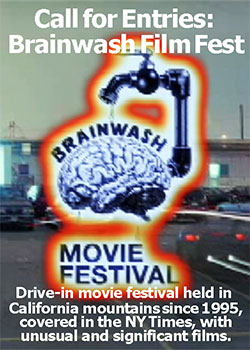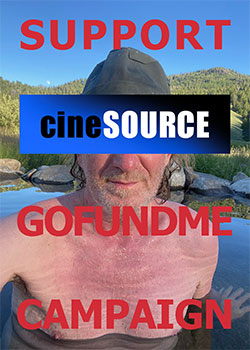Kerner Optical Out in Front with 3D
by Tony Reveaux
This article was initially published in the last issue of Film-Tape World, December 2007 but Tony Reveaux, the author, remained central to CineSource.
Kerner Optical is a movie with a happy ending -- and beginning. When George Lucas made his historic move creating the Letterman Digital Arts Center in the Presidio of San Francisco and transferring Industrial Light & Magic there from San Rafael, that didn't mean that those hallowed model shops and stately sound stages would be abandoned to ancient ruin. Lucas determined that the practical effects talent would remain there, all the better to service ILM effects projects.
This brainy bunch banded together in a management buyout a year ago to create and operate as a new independent entity, Kerner Optical LLC. They are in constant motion providing design and production services to the industry for film, television and commercial clients with model, creature, makeup, props, sets, pyro and mechanical engineering development.
Pushing the Future Forward in 3D
"I worked under ILM for 19 years," said Kerner president Mark Anderson, "my last title there was director of physical production. We've seen a lot of push in this industry right now with a lot of the majors saying they want to shoot 3D movies and the theaters are actually converting over to facilitate that."
For theaters that have installed the digital projection systems that can support it, 3D has been doing surprisingly good box office for an emerging niche with a premium ticket price. Pictures like Chicken Little and Meet the Robinsons have found some houses having their 3D screen outperforming the standard screens by as much as four-to-one.
Today only about 900 screens can show a fully 3D Beowolf, but predictions are in that by next year there should be over 3,000, and then the following year over 5,000 digital screens will be up. Starting in January, studio 3D projects will start rolling out to the aisles such as U2 3D; Journey 3D -- a remake of Verne's Journey to the Center of the Earth; Tintin; Monsters vs Aliens; How to Train Your Dragon; and Shrek 4.
Said Anderson, "The big surprise is that nobody expected this generation of stereo 3D to take off as quick as it did. Being able to shoot in HD is what has made it better. We think that film will be a thing of the past. Two ShoWests ago Mr. Lucas got up there with Mr. Spielberg, and everybody had 3D glasses on, so now for the first time, we don't have to be the market maker. We're looking at this process all the way from point of capture to display, starting with state-of-the-art 3D rigs, that goes down to television display in the home. We're also doing work within the feature film aspect and creating a new 3D pipeline; the software and enabling tools as well."
Eyezapoppin'
"We're building 3D camera rigs here with the new F23 Sony cameras," he said, "and we're also building 3D televisions. With these first generation televisions, they will not be the LCD shutter glasses which you are seeing with some of the other manufacturers. Like the recycle glasses that you are seeing in the 3D theaters presently, they are much more comfortable and relaxing on the eyes. As 3D rolls out, a lot of the theaters will use what's known as shutter glasses, and our stuff works with that. All the other companies using circular polaroids, our stuff works with that. We take the multi-platform position for now, as we see and contribute to a standard to emerge."
How far along is Kerner Optical on this ambitious three-fold path? Said
Yuska (Joe) Siuicki, one of the key development leads in the Kerner team; "We have finished our first 3D camera rig, that we will start building in multiples, based on the F23 camera. We have finalized all our prototyping within our 3D television display, and are going into manufacturing with that product on the shelf by mid-'08. Now we are putting together our own slate of movies to shoot in 3D to put into the theaters."
The proprietary 3D camera systems will not be sold or leased, but will be part of their service. "We're in-house for equipment like that," said Anderson. "It really takes specialized people to run that kind of equipment. Our goal is to find the correct projects to do. For feature films we'll send our crew and equipment out there to support those projects. You shoot different, you edit different, you direct different. The whole process is completely different."
HD is an expensive proposition to put together. Kerner's system is working with two of the Sony F23 cameras. There is no one-camera solution for shooting 3D at this point. You have to capture the right and left eye when you're shooting live action footage for 3D. Their camera control system is able to calculate and pull the appropriate convergence and set parallaxes so that you're actually not 'ripping peoples' eyes out,' as they call it. You have to be able to pick your object and determine how much you want it to come out of the screen, or how little you want it to come out of the screen.
3D TV, Oh My
"Everything needs to lead to the home at the end of the day," said Anderson. "Samsung has put together a 3D TV. Panasonic has a TV out there. Our main strategy is getting something on the screen. This is a new era for shooting in 3D."
"Virtually almost everything we do we can do it here on the property," said Siuicki. "Machine shop, optical. We're creating our own chip, the KG900, which will be used for all kinds of aspects of processing and decoding. The 3D signal is hidden inside the 2D signal with no degradation to the HD picture. So the set will work as well with 2D broadcasts as with 3D. Major changes to the LCD screen, to the hardware inside, the viewing mechanism, the board is different. Mitsubishi and Samsung are using a shuttered approach, which is diametrically opposite to the approach we are using. Ours is basically the same approach as is being used in the theaters. There are many feature films in 3D already in the can. Stereoscopic 3D sports is really phenomenal."
3D TV will start out mid-to-late December. There will be broadcast starting with sporting events and live concerts. They'll go to satellite and then come down to the 3D digital theaters. The narrowcast will be first. Then it will integrate when there are enough sets out there. So for Samsung, and Mitsubishi, as we go through next year the projections of those companies is they're saying that there should be 1.5 to two million sets going through 2008.
For the aftermarket, 3D DVD's can be played on any standard DVD player and fed to the 3D TV set which will recognize, decode and display the 3D signal. The difference here will be with Kerner's chip working inside the television. There are different ways to deliver the stereoscopic signal, so the chip will differentiate between them all automatically, as well as for conventional broadcasting.
Set, Ready, Go
Said Anderson, "We're trying to create a very stable foundation for our camp and at the same time make our services available to others while using services from other groups as well. 3D is just another tool in our toolbag of what Kerner delivers here. We're a one-stop shop. We've been known for years of doing miniature event and pyro work for movies. We still do that, that still is our niche in the industry. 3D is just another technical skill we are adding on to what we do. It’s a natural progression for this company."
"Kerner's real push is in entertainment, actually doing content itself. We are more inspired with making the 3D movies than the display end of this industry. We think we have the best cameras and equipment to do it and a great crew. We're building a slate of our own projects to do and shoot in 3D."
Tony Reveaux is a San Francisco-based writer and consultant and can be reached at . A senior writer, he has been contributing to Film/Tape World since 1990.
Posted on Oct 10, 2011 - 09:54 PM
by Tony Reveaux
This article was initially published in the last issue of Film-Tape World, December 2007 but Tony Reveaux, the author, remained central to CineSource.
Kerner Optical is a movie with a happy ending -- and beginning. When George Lucas made his historic move creating the Letterman Digital Arts Center in the Presidio of San Francisco and transferring Industrial Light & Magic there from San Rafael, that didn't mean that those hallowed model shops and stately sound stages would be abandoned to ancient ruin. Lucas determined that the practical effects talent would remain there, all the better to service ILM effects projects.
This brainy bunch banded together in a management buyout a year ago to create and operate as a new independent entity, Kerner Optical LLC. They are in constant motion providing design and production services to the industry for film, television and commercial clients with model, creature, makeup, props, sets, pyro and mechanical engineering development.
Pushing the Future Forward in 3D
"I worked under ILM for 19 years," said Kerner president Mark Anderson, "my last title there was director of physical production. We've seen a lot of push in this industry right now with a lot of the majors saying they want to shoot 3D movies and the theaters are actually converting over to facilitate that."
For theaters that have installed the digital projection systems that can support it, 3D has been doing surprisingly good box office for an emerging niche with a premium ticket price. Pictures like Chicken Little and Meet the Robinsons have found some houses having their 3D screen outperforming the standard screens by as much as four-to-one.
Today only about 900 screens can show a fully 3D Beowolf, but predictions are in that by next year there should be over 3,000, and then the following year over 5,000 digital screens will be up. Starting in January, studio 3D projects will start rolling out to the aisles such as U2 3D; Journey 3D -- a remake of Verne's Journey to the Center of the Earth; Tintin; Monsters vs Aliens; How to Train Your Dragon; and Shrek 4.
Said Anderson, "The big surprise is that nobody expected this generation of stereo 3D to take off as quick as it did. Being able to shoot in HD is what has made it better. We think that film will be a thing of the past. Two ShoWests ago Mr. Lucas got up there with Mr. Spielberg, and everybody had 3D glasses on, so now for the first time, we don't have to be the market maker. We're looking at this process all the way from point of capture to display, starting with state-of-the-art 3D rigs, that goes down to television display in the home. We're also doing work within the feature film aspect and creating a new 3D pipeline; the software and enabling tools as well."
Eyezapoppin'
"We're building 3D camera rigs here with the new F23 Sony cameras," he said, "and we're also building 3D televisions. With these first generation televisions, they will not be the LCD shutter glasses which you are seeing with some of the other manufacturers. Like the recycle glasses that you are seeing in the 3D theaters presently, they are much more comfortable and relaxing on the eyes. As 3D rolls out, a lot of the theaters will use what's known as shutter glasses, and our stuff works with that. All the other companies using circular polaroids, our stuff works with that. We take the multi-platform position for now, as we see and contribute to a standard to emerge."
How far along is Kerner Optical on this ambitious three-fold path? Said
Yuska (Joe) Siuicki, one of the key development leads in the Kerner team; "We have finished our first 3D camera rig, that we will start building in multiples, based on the F23 camera. We have finalized all our prototyping within our 3D television display, and are going into manufacturing with that product on the shelf by mid-'08. Now we are putting together our own slate of movies to shoot in 3D to put into the theaters."
The proprietary 3D camera systems will not be sold or leased, but will be part of their service. "We're in-house for equipment like that," said Anderson. "It really takes specialized people to run that kind of equipment. Our goal is to find the correct projects to do. For feature films we'll send our crew and equipment out there to support those projects. You shoot different, you edit different, you direct different. The whole process is completely different."
HD is an expensive proposition to put together. Kerner's system is working with two of the Sony F23 cameras. There is no one-camera solution for shooting 3D at this point. You have to capture the right and left eye when you're shooting live action footage for 3D. Their camera control system is able to calculate and pull the appropriate convergence and set parallaxes so that you're actually not 'ripping peoples' eyes out,' as they call it. You have to be able to pick your object and determine how much you want it to come out of the screen, or how little you want it to come out of the screen.
3D TV, Oh My
"Everything needs to lead to the home at the end of the day," said Anderson. "Samsung has put together a 3D TV. Panasonic has a TV out there. Our main strategy is getting something on the screen. This is a new era for shooting in 3D."
"Virtually almost everything we do we can do it here on the property," said Siuicki. "Machine shop, optical. We're creating our own chip, the KG900, which will be used for all kinds of aspects of processing and decoding. The 3D signal is hidden inside the 2D signal with no degradation to the HD picture. So the set will work as well with 2D broadcasts as with 3D. Major changes to the LCD screen, to the hardware inside, the viewing mechanism, the board is different. Mitsubishi and Samsung are using a shuttered approach, which is diametrically opposite to the approach we are using. Ours is basically the same approach as is being used in the theaters. There are many feature films in 3D already in the can. Stereoscopic 3D sports is really phenomenal."
3D TV will start out mid-to-late December. There will be broadcast starting with sporting events and live concerts. They'll go to satellite and then come down to the 3D digital theaters. The narrowcast will be first. Then it will integrate when there are enough sets out there. So for Samsung, and Mitsubishi, as we go through next year the projections of those companies is they're saying that there should be 1.5 to two million sets going through 2008.
For the aftermarket, 3D DVD's can be played on any standard DVD player and fed to the 3D TV set which will recognize, decode and display the 3D signal. The difference here will be with Kerner's chip working inside the television. There are different ways to deliver the stereoscopic signal, so the chip will differentiate between them all automatically, as well as for conventional broadcasting.
Set, Ready, Go
Said Anderson, "We're trying to create a very stable foundation for our camp and at the same time make our services available to others while using services from other groups as well. 3D is just another tool in our toolbag of what Kerner delivers here. We're a one-stop shop. We've been known for years of doing miniature event and pyro work for movies. We still do that, that still is our niche in the industry. 3D is just another technical skill we are adding on to what we do. It’s a natural progression for this company."
"Kerner's real push is in entertainment, actually doing content itself. We are more inspired with making the 3D movies than the display end of this industry. We think we have the best cameras and equipment to do it and a great crew. We're building a slate of our own projects to do and shoot in 3D."
Tony Reveaux is a San Francisco-based writer and consultant and can be reached at . A senior writer, he has been contributing to Film/Tape World since 1990.
Posted on Oct 10, 2011 - 09:54 PM























